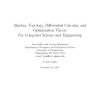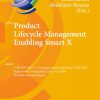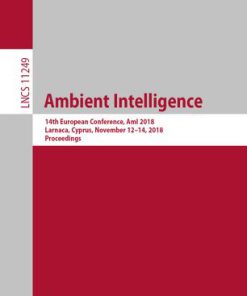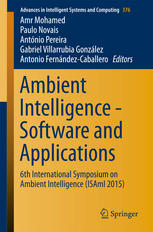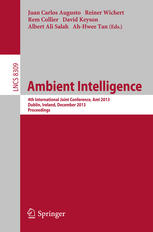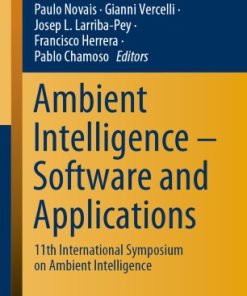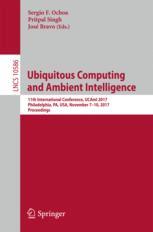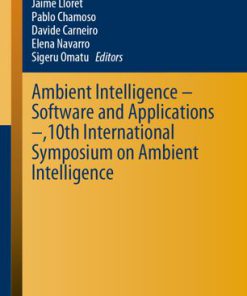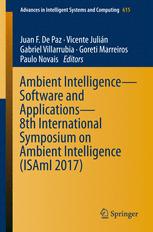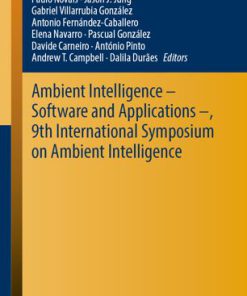Ambient Intelligence Software and Applications 5th International Symposium on Ambient Intelligence 1st Edition by Carlos Ramos, Paulo Novais, Celine Ehrwein Nihan, Juan Corchado Rodriguez ISBN 3319075950 9783319075952
$50.00 Original price was: $50.00.$25.00Current price is: $25.00.
Ambient Intelligence Software and Applications 5th International Symposium on Ambient Intelligence 1st Edition by Carlos Ramos, Paulo Novais, Céline Ehrwein Nihan, Juan M. Corchado Rodríguez – Ebook PDF Instant Download/Delivery: 3319075950, 978-3319075952
Full download Ambient Intelligence Software and Applications 5th International Symposium on Ambient Intelligence 1st Edition after payment
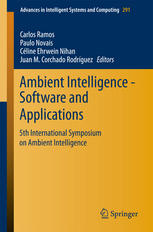
Product details:
ISBN 10: 3319075950
ISBN 13: 978-3319075952
Author: Carlos Ramos, Paulo Novais, Céline Ehrwein Nihan, Juan M. Corchado Rodríguez
Ambient Intelligence (AmI) is a recent paradigm emerging from Artificial Intelligence (AI), where computers are used as proactive tools assisting people with their day-to-day activities, making everyone’s life more comfortable.
Another main concern of AmI originates from the human computer interaction domain and focuses on offering ways to interact with systems in a more natural way by means user friendly interfaces. This field is evolving quickly as can be witnessed by the emerging natural language and gesture based types of interaction.
The inclusion of computational power and communication technologies in everyday objects is growing and their embedding into our environments should be as invisible as possible. In order for AmI to be successful, human interaction with computing power and embedded systems in the surroundings should be smooth and happen without people actually noticing it. The only awareness people should have arises from AmI: more safety, comfort and wellbeing, emerging in a natural and inherent way.
ISAmI is the International Symposium on Ambient Intelligence and aiming to bring together researchers from various disciplines that constitute the scientific field of Ambient Intelligence to present and discuss the latest results, new ideas, projects and lessons learned, namely in terms of software and applications, and aims to bring together researchers from various disciplines that are interested in all aspects of this area.
Ambient Intelligence Software and Applications 5th International Symposium on Ambient Intelligence 1st Table of contents:
Context-Aware Automatic Service Selection Mechanism for Ambient Intelligent Environments
- Introduction
- Related Work
- Concept of the Petri Nets
- Context-Aware Automatic Service Selection Mechanism
- 4.1 Modeling Principles
- 4.2 Reasoning about Context
- Illustrative Scenario: Smart Home
- Conclusion and Future Work
- References
A Multimodal Conversational Agent for Personalized Language Learning
- Introduction
- The Test Pedagogical System
- Preliminary Evaluation
- Conclusions
- References
Power Indices of Influence Games and New Centrality Measures for Agent Societies and Social Networks
- Introduction and Preliminaries
- Power Indices and New Centrality Measures
- Cases of Study
- Conclusions and Future Work
- References
Self-Healing Multi-Agent Prototyping System for Crop Production
- Introduction
- Related Works
- 2.1 Adaptive Service Framework (ASF)
- 2.2 Context Awareness for Self-adaptive Software
- Design of SHMAP
- 3.1 Basic Design Concepts
- 3.2 System Architecture
- 3.3 Meta Policy for Self-Healing
- Implementation and Evaluation of SHMAP
- Conclusion
- References
The Impact of Using Gamification on the Eco-driving Learning
- Introduction
- The Eco-driving Game
- Evaluation of Eco-driving Game
- 3.1 Experimental Design
- 3.2 Results
- Conclusions
- References
Person Localization Using Sensor Information Fusion
- Introduction
- System Architecture
- 2.1 Body Sensor Units and Sensor Fusion
- 2.2 Learning System and Mobile Application
- Experimental Results
- Conclusion
- References
Improving Modularity, Interoperability, and Extensibility in Ambient Intelligence
- Introduction
- Current Challenges in AmI
- Architecture
- Case Study of Context-Aware Multimodal Communication System
- Conclusions
- References
RETRACTED CHAPTER: UAVs Applied to the Counting and Monitoring of Animals
- Introduction
- Background
- 2.1 Livestock Detection
- 2.2 Multirotor System
- 2.3 Convolutional Neural Network
- System Overview
- 3.1 Runtime Operation
- 3.2 Visual Recognition
- Results and Conclusions
- References
Easy Development and Use of Dialogue Services
- Introduction
- Related Work
- Architecture
- Service Development Support Middleware
- 4.1 Interaction Protocol
- 4.2 Script Engine Middleware
- 4.3 Web Interface for Web Service Invocation
- Case Study
- Conclusion
- References
Design and Implementation of the Intelligent Plant Factory System Based on Ubiquitous Computing
- Introduction
- Design of the Proposed Intelligent Plant Factory System
- Implementation
- 3.1 Implementation Ontology for Intelligent Control Service
- 3.2 Implementation of the Proposed Intelligent Plant Factory System
- Conclusions
- References
Getting and Keeping Aged People Socially Included: Trials with Real End-Users of the EasyReach System
- Introduction
- System and Social Environment
- Trials Setting and Assessment Methodology
- Results
- 4.1 Reaction Patterns
- Conclusions
- References
A General-Purpose mHealth System Relying on Knowledge Acquisition through Artificial Intelligence
- Introduction
- Mobile Monitoring System Architecture
- Use-Cases
- 3.1 Monitoring of Apneas
- 3.2 Fall Detection
- Conclusion
- References
Video Processing Architecture: A Solution for Endoscopic Procedures Results
- Introduction
- Problem Definition
- Related Work
- Proposed Architecture
- Conclusions and Future Work
- References
A Multi-agent Platform for Hospital Interoperability
- Introduction
- Background
- 2.1 Multi-Agent Systems for Interoperability
- 2.2 AIDA
- Archetype for Agents Monitoring
- 3.1 Architecture and Components Description
- Implementation Results
- Conclusions and Future Work
- References
Mobile Solution Using NFC and In-Air Hand Gestures for Advertising Applications
- Introduction
- System Architecture
- A Real Application Scenario of Using the Mobile Solution
- Conclusion
- References
Ubiquitous Sensorization for Multimodal Assessment of Driving Patterns
- Introduction
- Related Work
- Multimodal Assessment System
- Conclusions and Future Work
- References
CloudFit: A Cloud-Based Mobile Wellness Platform Supported by Wearable Computing
- Introduction
- Related Work
- CloudFit: Cloud-Based Mobile Wellness Platform
- 3.1 Platform Overview
- 3.2 Platform Features
- 3.3 Architecture
- 3.4 Usability
- 3.5 Example of Applications
- Conclusions and Future Work
- References
Developing Ambient Support Technology for Risk Management in the Mining Industry
- Introduction
- Methods
- 2.1 Material
- 2.2 Theory for Persuasive Technology and Behavior Change
- 2.3 Participants
- Results and Discussion
- 3.1 Empowerment and Motivational Factors in End Users
- 3.2 Balancing Ethical Aspects with Health and Productivity
- 3.3 Human Resources Perspective and Cost
- Conclusions
- References
RETRACTED CHAPTER: Wireless Sensor Networks to Monitor Elderly People in Rural Areas
- Introduction
- Proposed System
- 2.1 Passive Localization
- 2.2 Monitoring Users
- 2.3 Detecting Anomalies
- Case Study
- Results and Conclusions
- References
Context-Aware Module for Social Computing Environments
- Introduction
- Related Work
- PANGEA Architecture
- 3.1 Extensions for Context-Aware Computing
- Conclusions
- References
Wireless Multisensory Interaction in an Intelligent Rehabilitation Environment
- Introduction
- Some Current Rehabilitation Systems
- A New Proposal of a Rehabilitation System
- 3.1 Physiotherapist
- 3.2 Elderly Patient
- Discussion and Conclusions
- References
Lateral Fall Detection via Events in Linear Prediction Residual of Acceleration
- Introduction
- Proposed Method
- Experiment
- Results
- Discussion
- References
Fighting Elders’ Social and Technological Exclusion: The TV-Based Approach
- Introduction
- Related Work
- Architecture
- 3.1 VCoTV Service
- 3.2 The Smart Remote Control
- 3.3 Service Provider Module
- Prototype Implementation
- 4.1 Application Server Module
- 4.2 Client Module
- 4.3 Smart Remote Control Module
- Evaluation
- Conclusion
- References
A Decision Support System for Medical Mobile Devices Based on Clinical Guidelines for Tuberculosis
- Introduction
- Mobile Health and Tuberculosis’ Guideline
- 2.1 mHealth
- 2.2 Tuberculosis
- Methodology
- Tuber’s Prototype
- 4.1 The Clinical Guideline Tuberculosis: Case Study
- Evaluation
- Conclusions and Future Work
- References
New Applications of Ambient Intelligence
- Introduction
- What Is Holding It All Back?
- Ambient Intelligence: Diversity and Innovation
- Conclusions
- References
AmI: Monitoring Physical Activity
- Introduction
- 1.1 Related Work
- 1.2 VirtualECare
- VirtualECare2
- 2.1 Physical Activity Monitor
- Conclusions and Future Work
- References
RETRACTED CHAPTER: Multi-agent Technology to Perform Odor Classification
- Introduction
- Case Study: Development of a VO for Odor Classification
- 2.1 Integration in a Multi-agent Platform (PANGEA)
- 2.2 Algorithms: Classification Method of Odor Data (e-BPNN)
- 2.3 Principle of QCM Sensors
- 2.4 Odor Sensing Hardware System
- 2.5 Measurement of Odor Data
- Conclusions and Results
- References
People also search for Ambient Intelligence Software and Applications 5th International Symposium on Ambient Intelligence 1st:
ambient intelligence definition
ambient weather software download
j. ambient. intell. humaniz. comput
what is ambient intelligence with example
zoom ambisonic player
Tags:
Carlos Ramos,Paulo Novais,Celine Ehrwein Nihan,Juan Corchado Rodriguez,Ambient,Intelligence,Software,Applications,International,Symposium,Ambient,Intelligence 1st
You may also like…
Computers - Computer Science
Computers - Networking
Computers - Computer Science


